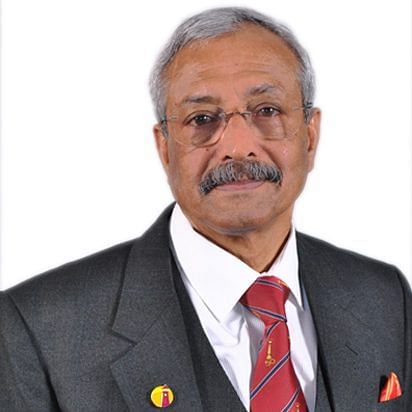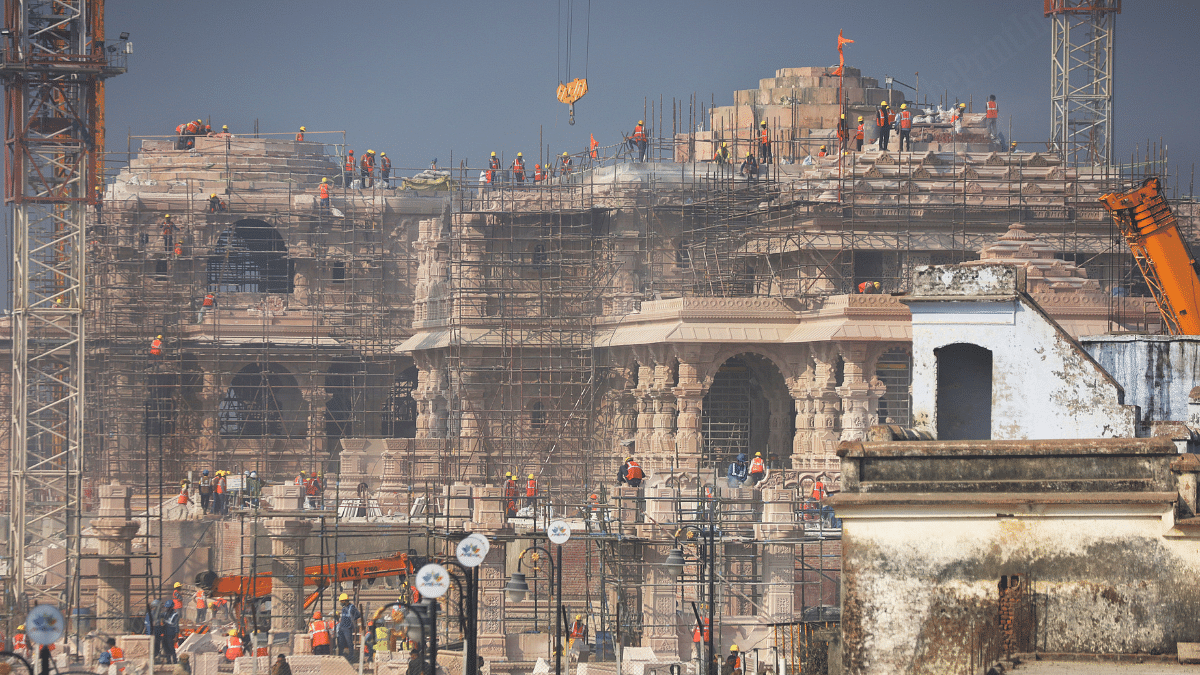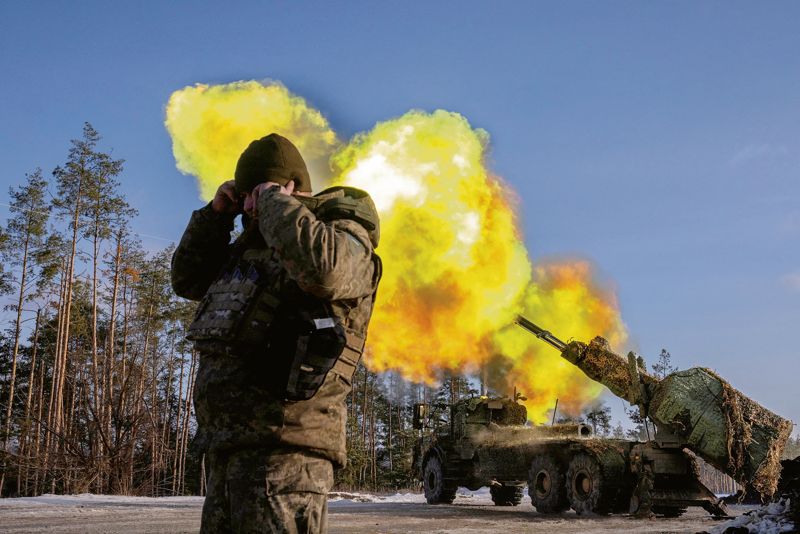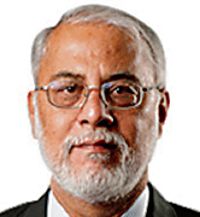Current Events :












LT GENERAL PRAKASH MENON19 December, 2023

Text Size: A- A+
The Shri Ram Janmabhoomi Teerth Kshetra is supposedly inviting about 8,000 people for the Ram Mandir opening ceremony on 22 January 2024. From Prime Minister Narendra Modi to Reliance chairman Mukesh Ambani, the list includes prominent figures from varied fields as well as families of 50 ‘Kar Sevaks’ and a representative each from 50 countries. The invitation has also gone out to former chiefs of the armed forces, a step worth recounting in the broader framework of civil-military relations.
It is verified that a flag rank veteran called up the former chiefs, seeking to ascertain their inclination to attend the function. It is understood that most of them declined. Those who indicated their willingness or did not directly turn down the invite have received a formal invitation. In terms of civil-military relations, the question that arises is an ethical one: How will the attendance of former chiefs at the 22 January event impact the secular and apolitical foundations of India’s military institution?
Before attempting to answer this, it becomes necessary to underscore the current political and religious scenario at the national level. India’s constitutionally secular foundation has been under contestation for some time now, deepening religious polarisation. This divide is increasingly reflected in the conduct of domestic politics, unravelling the national social cohesion. This is especially after the 1992 demolition of the Babri Masjid by Hindu mobs supported by political communities seeking a constitutional interpretation that favoured a Hindu majoritarian agenda.
The Ayodhya temple issue has found legal closure both symbolically and historically. But the 22 January consecration ceremony marks a major ‘victory’ for a significant portion of the Hindu population over the perceived ravages of ‘Muslim rule’ in pre-Independence India. The timing of the consecration is expected to provide electoral tailwinds to the Bharatiya Janata Party (BJP) in the 2024 Lok Sabha election. The context is not only religiously charged but also carries definite political implications.

With regrets
Col C T Arasu (Retd)
President of Indian Ex-Services League Tamil Nadu and Senior Vice President in the National Unit of Indian Ex-Services League Delhi
17-12-23
9360068354
9444891760
MUST READ THIS ARTICLE POSTED ON ANOTHER GROUP*
*The whole idea of #Agniveer is the brain child of Kunwar Vikram Singh Chairman #capsi.*
In fact, that time, I was working on a model of employing ex servicemen for global opportunities. I had gone to discuss with him for his help to negotiate with central govt to change certain policies to allow training in India for such jobs. That time in detail, I told him about huge existing opportunities.
Only barrier was Indian laws do not permit training in automatics specially of western origin. This barrier was forcing us to have such certificate training in foriegn land. This is where, I had discussion with some companies of Israel and Poland. Vikram Singh also had discussion with few companies in Middle East, USA and Australia.
That time UPA was in power. Things did not find favour from central govt. Their stand was ex servicemen are paid pension hence govt shall not allow their use as mercenaries as this may create, in long terms a security threat to India herself.
Then came govt change. Vikram Singh probably pushed it to RSS. They liked the idea. They were in any case trying to use ex servicemen as their Shakha Prabandhak. The idea that some pro RSS corporate house like Adani, Ambani, InfoSys, Mahendra can employ Agniveers as security guards and on weekends they xan attend RSS Shakhas. This way without spending money, RSS will be able to raise a private army of almost 2 lakh agniveers over say 5 to 7 years.
Second objective is that it will dilute caste based regiments and in few years these will be converted into mixed Regts naming them after RSS promoted Indian heroes like Baji Rao Regt.
The farmers agitation triggered fast action. One sepoy of Jat Regt posted a vdo loading rifle to support farmers. Reports of many serving soldiers supporting farmers created panic in RSS. In fact restlessness among serving soldiers forced modi to withdraw farmers bills.
Result. Inspite of Army’s reservation, they imposed the scheme of Agniveers over army with help of few key Generals. Internally there was big opposition to scheme. That’s why you find not much detailed deliberation about the scheme was done.
So here we have this Agniveers who will later be hired by Adani and Ambani and others to help Modi and RSS have their own private army. But they are not realising that many global private military companies are already planning to offer better opportunities to Agniveers.
Why shall an #Agniveer work for Adani say for Rs 15000 per month when he can get Rs 70000 in global market. This is where it opens a pandora box. Wherein, we will soon see rise of Modern Pindaris (Mercenories) in global scene. Legally govt can not stop agniveers joining foriegn armies or mercenaries. I have no doubt such bands of private soldiers will be easily exploited to the extent of creating threat to India herself. But these idiots are not open to discussions and reason. God bless India.
*Is he the same character who authored the AV Singh Committee Report???*

Indian Navy’s missile boats (INS NIPAT) hitting Karachi port during operation Trident
New Delhi: Vijay Diwas, celebrated on December 16th every year, commemorates India’s resounding victory in the 1971 Indo-Pak war, a historic event that led to the liberation of East Pakistan, now Bangladesh, after the devastation of Karachi Port, which was scripted solely due to the determined leadership of then Naval Chief Admiral Nanda.
Brainchild of then Naval Chief Admiral Nanda, Operations Trident and Python were at the core of India’s victory in 1971, leading to the decisive triumph of India over Pakistani forces and the surrender of the enemy on December 16, 1971 and the creation of Bangladesh from the erstwhile East Pakistan.
– Every year, the nation celebrates Vijay Diwas on 16th December. But do we know the story behind the valour that brought victory for India in the 1971 war against Pakistan?
– Brain child of then Naval Chief Admiral Nanda, Operations Trident and Python were at the core of India’s victory in 1971, leading to surrender of Pakistani Army on December 16, 1971 and the creation of Bangladesh from the erstwhile East Pakistan.
– The trail of devastation left behind by Operations Trident and Operation Python sent a shiver down the spine of Pak establishment. Karachi Port kept burning for seven days. It displayed the strategic prowess and determination of the Indian Navy under the stellar leadership of Admiral Nanda.
This incredible feat was accomplished greatly because of the valour, determination and action-oriented stellar leadership of Admiral Nanda. The Indian Navy devastated Karachi Port, the citadel of Pakistani military establishment and economy, demonstrating his strategic prowess and unwavering determination to take on the enemy head-on.
Operations Trident and Python – an excellent strategic and meticulous war planning of Admiral Nanda – changed the course of war. The trail of devastation left behind by the most audacious attack by the heroes of Admiral Nanda sent a shiver down the spine of Pak establishment. Karachi Port kept burning for seven days. It displayed the strategic prowess and determination of the Indian Navy under the stellar leadership of Admiral Nanda and scripted a rare victory in the world’s war time annals.
On December 3, 1971 Pakistan had launched an unprovoked attack on Indian airfields. India faced challenges from both West Pakistan and East Pakistan and was left with no choice but to respond with decisive force. Known for his aggressive and action-oriented leadership, Admiral Nanda, popularly known as Charles Nanda, went for a swift and bold attack on the enemy on December 4 – Operation Trident.
Admiral Nanda decided the deadly attack on the Karachi harbour to ensure a complete blockade on the Pakistani Navy, effectively cutting the western command from East Pakistan. In the Eastern theatre, he planned the deployment of the aircraft carrier INS Vikrant in the Gulf of Bengal off East Pakistan to open a front from seaward to completely blockade it and prevent reinforcements – ammunition and all supplies from reaching it. Karachi Port burnt for seven days, leaving Pakistani forces and economy totally crippled. It displayed the strategic prowess and determination of Admiral Nanda.
The 1971 War was the only war in which the Indian Navy took part and brought rare laurels to the nation. Touted as one of the world’s most daring war strategies, Operations Trident destroyed and sank battle-class destroyer PNS Khaibar, ammunition carrier Venus Challenger, an adjutant-class minesweeper PNS Muhafiz, and destroyer PNS Shah Jahan.
Operation Python launched on the night of December 8-9, 1971 proved the last nail in Pakistan’s coffin. Admiral Nanda showed extreme courage and valour to go back and attack the enemy in his citadel a second time. The Indian Navy assaulted the gathering of boats off the shoreline of Karachi. Pakistani armada tanker PNS Dacca was destroyed and the Kemari oil storage was again put on fire, bringing complete devastation to Karachi port. India endured no misfortunes.
The ferocious and swift Operation Trident proved and achieved what Admiral Nanda had said two years ago in a media interview in 1969 when he was the Flag Officer Commanding-in-Chief of Western Naval Command: “…You have my word that given the opportunity, the Indian Navy will make the world’s biggest bonfire of it.” He proved, accomplished and showed to the world the mettle he epitomized.
Rightly hailed and revered as the ‘Man Who Bombed Karachi’ Admiral Nanda was awarded Padma Vibhushan, the second highest civilian award, for his outstanding courageousness during the war.
However, fifty-two years on, what continues to disappoint Naval veterans is the sordid denial of the of ‘Admiral of the Fleet’ honour to Indian Navy and then Naval Chief, who planned and executed Operation Trident and Python with finesse on the night of December 4, 1971, recording the only victory in the annals of maritime war.
A befitting acknowledgement of the magnificent services and extraordinary leadership Admiral Nanda provided to the Indian Navy during the most critical juncture in the nation’s history will be the conferment of most deserving and long awaited ‘Admiral of the Fleet’ honour upon him posthumously which will also serve as an inspiration for the future generations of naval officers.

New Delhi: China followed “wolf-warrior diplomacy” and “salami-slicing” tactics with impunity browbeating smaller neighbours and it took the Indian Army to show to the world that “enough is enough” and challenge the “neighbourhood bully”, says Gen Manoj Mukund Naravane, the 28th Chief of Army Staff, recounting the Indian response to the Chinese aggression in Eastern Ladakh in 2020. In his memoirs ‘Four Stars of Destiny’, Naravane, providing a rare insight into the deadly Galwan Valley clashes, says Chinese President Xi Jinping will not forget June 16 any time soon as China’s People’s Liberation Army suffered “fatal casualties” for the first time in over two decades in the fighting.
Naravane, one of the foremost Army Generals, provided a gripping account of the India-China confrontation before and after the deadly Galwan Valley incident, India’s overall response to the Chinese action and how it served as a catalyst to firm up the Army’s combat readiness along the Line of Actual Control (LAC).
“It was one of the saddest days of my entire career,” says Naravane recalling the death of 20 Army personnel in the Galwan Valley clashes in June 2020.
His tenure as the Army Chief from December 31, 2019 to April 30, 2022 was primarily marked by the Chinese challenges along the contested border as well as the rolling out of long-term reform measures to enhance the combat capabilities of the force.
“June 16 is (Chinese President) Xi Jinping’s birthday. This is not a day he will forget any time soon. For the first time in over two decades, the Chinese and the PLA had suffered fatal casualties,” Naravane writes.
“They had been following wolf-warrior diplomacy and salami-slicing tactics everywhere with impunity, browbeating smaller neighbours like Nepal and Bhutan, while staking their ever-increasing claims in the South China Sea, without having to pay any costs, especially in terms of human lives.”
“It took India and the Indian Army to show to the world that enough is enough and to challenge the neighbourhood bully.”
Delving into the overall situation along the frontier, Naravane, at the same time, suggests having a “non-aggression” pact between the two countries pending the settlement of the overall boundary dispute, saying it would go a long way in restoring confidence and pave the way for de-escalation and de-induction of forces.
‘Four Stars of Destiny’ published by Penguin Random House India will hit the stands next month.
On the Galwan Valley incident, Naravane says it occurred in view of the Chinese PLA refusing to remove two tents that it had erected in Patrolling Point 14 (PP-14), adding following the adversary’s refusal, the Indian Army decided to pitch its own tents in the same general area.
The eastern Ladakh border row began in May 2020. Naravane says flag-level meetings had been continuing at other locations then, including at PP-15 and PP-17A, where troops fell back over agreed distances, thereby reducing the chances of violent face-offs.
“At PP-14, however, whenever we asked the PLA to remove their tents, they kept changing their stance. From ‘some more time was needed’, to ‘we will check with our superiors’, to it ‘being beyond the mandate of the talks’.”
“From this stonewalling, it became evident that there had been no intention of removing those tents in the first place. To counter this, we also decided to pitch our own tents in the same general area,” he writes.
Naravane says when Indian Army personnel went to pitch the tents, there was a violent reaction from the Chinese side.
“Col Santosh Babu, Commanding Officer of 16 BIHAR, went forward with a small party of troops to attempt to defuse the situation but the PLA were in no mood to relent and attacked the CO’s party too,” he says.
“Thereafter, it became a free-for-all. With darkness setting in, both sides rushed in additional troops and a see-saw engagement continued throughout the night,” he recounts.
Although armed, neither side opened fire, instead using batons or clubs and throwing or rolling down stones on each other’s positions, he says.
The former Army Chief says due to better connectivity on their side, the PLA were able to move troops forward in armoured personnel carriers which changed the balance in their favour.
Naravane says he told then Northern Army Commander Lt Gen YK Joshi during a phone call at 1:30 am on June 16 that the Army must hit back and make the PLA pay the price for their misadventure. “Daylight revealed a not-so-favourable situation.”
“Few Jawans who could not make it back at night or who had been separated started trickling back. Five Jawans had died of injuries in the melee. The next morning, as the head count was taken, we realised many were missing,” he says.
“As tense negotiations began, many of our boys, who had either got disoriented or had been briefly detained by the PLA without food or medical aid, returned to base,” he says.
“However, 15 of them succumbed to the combined effects of their injuries and hypothermia. It was one of the saddest days of my entire career.”
The Galwan Valley clashes on June 15, 2020 marked the most serious military conflicts between India and China in decades and the full extent of the deadliest confrontation was known the next day.
“We are in a profession where death is always lurking around the corner.
“Every patrol or ambush can be your last. As a Company and Battalion Commander, my unit had suffered casualties, and I was always stoic in the face of adversity or bad news. Yet, losing 20 men in a day was hard to bear,” he notes.
About the casualties on the Chinese side, Naravane says it was evident that they “too suffered substantially”.
“Our men who were in Chinese hands had been kept out in the open and they had seen several bodies being fished out of the river. Whenever that happened, they were subjected to a fresh round of beatings,” Naravane writes.
“The sheer savagery of their response was in itself indicative of the losses they had suffered. Initially, they did not admit to any casualties at all; then many months later, admitted to four or five killed, including the CO on their side,” he says.
Naravane also mentioned a report by a group of Australian researchers that put the figure of Chinese fatalities to at least 38, A separate Russian (TASS) report put the figure closer to 45 killed, which was consistent with other intelligence reports, including those from the US, he says.
Naravane says the time is ripe for the resumption of the special-representative level talks to settle the border question between the two sides.
“Pending the settlement of the boundary dispute, which is likely to be time-consuming, articulation of a ‘non-aggression’ pact between the two countries would go a long way in restoring confidence, paving the way for de-escalation and de-induction of forces from Tibet/Ladakh,” he said.
“Such a pact would be somewhat akin to what China and the ASEAN countries are attempting to formalise,” he said.
The former Army Chief says the crisis in eastern Ladakh served as a catalyst for the Army’s rebalancing to the northern front. The Army moved many key units to the northern front from other parts following the Chinese aggression.
“Though still inadequate, the increase in force ratios on the Northern Front will definitely make the PLA think twice before embarking on any misadventure, especially now that we have the offensive capability to take the battle into Chinese territory,” Naravane says.
“In our posture against China, we have moved up from dissuasive deterrence (defensive) to credible deterrence (offensive defence). With these developments, the PLA must have realised that a military solution to the border problem is improbable,” he adds.
‘Wolf-warrior’ diplomacy is a term used for a kind of assertive diplomacy. Salami Slicing is a tactic used to capture territory piece by piece.

The use of ATT technology facilitates accurate engagement with moving targets. Currently, the T-90 tanks are manually positioned in order to attack a target precisely
DAC has paved way for procurement of this tech, which will enable tanks to track & hit targets with more precision. As of now, T-90 tanks are positioned manually to hit targets.
The T-72 tanks will be gradually replaced by 1,700 Future Ready Combat Vehicles (FRCV), which the Indian Army is currently procuring. Battlefield Management System equipment will be installed on the FRCVs (BMS).
In a meeting on November 30, the Defence Acquisition Council (DAC) has reportedly approved the purchase and integration of two technological kinds for T-90 tanks: the Digital Ballistic Computer (DBC) and Automatic Target Tracker (ATT), both of which are a component of the fire control system.
In essence, an AoN is the ministry of defense’s approval given at the outset of the procurement procedure. The mainstay of the Indian Army’s armoured capabilities are the T-90 and T-72 tanks, which are manufactured in Russia.
Approximately 475 additional T-90 tanks are being developed, and the India Army reportedly has up to 1,200 of them in service.
According to a defence ministry official, the 1,200 tanks that are now in use will be refurbished, but the new tanks will have an integrated ATT, the source continued.
The official explained how this technology will benefit the Army, saying that it will “help the T-90s get better sight to spot enemy tanks easily.”
The use of ATT technology facilitates accurate engagement with moving targets. Currently, the T-90 tanks are manually positioned in order to attack a target precisely.
Based on the atmospheric conditions, the DBC, which powers the fire guidance system, determines the round’s course. The temperature inside the tank, the ambient temperature, and the wind’s direction and speed all have an impact on the performance of a round of ammunition. To hit an exact target, the DBC bases its computations on all of these variables.
The tanks’ existing analogue computer is being replaced with a digital one to eliminate the possibility of prejudice and human mistake.
The Indian Army also uses over 2,400 T-72 tanks, which are not equipped with the ATT and DBC, in addition to the T-90s.
The T-72 tanks will be gradually replaced by 1,700 Future Ready Combat Vehicles (FRCV), which the Indian Army is currently procuring. Battlefield Management System equipment will be installed on the FRCVs (BMS).


SIX months into its counter-offensive, Ukraine has managed to advance just 17 km. Russia fought for 10 months around Bakhmut in the east last year to advance about 6 km. The commander-in-chief of Ukraine’s armed forces, Gen Valery Zaluzhny, in an interview to The Economist last month, observed that like in World War I, “we have reached the level of technology that puts us into a stalemate.” The General’s view is that you would need a huge technology breakthrough to change things.
Ukraine claims that half of Russian artillery and a third of its armoured vehicles have been destroyed by drones.
When the Ukraine counter-offensive began in June, there were expectations that a breakthrough would demonstrate to Russia that the war could not be won. Instead, last week, an emboldened and confident Russian President Vladimir Putin said at a news conference in Moscow that there would be no peace till Russian goals of “de-Nazification, de-militarisation and a neutral status” of Ukraine were met.
Zaluzhny said his thesis had been borne out by the fate of the most recent Russian ‘counter-counter-offensive’ aimed at Avdiivka in eastern Ukraine, where the Russians have been able to advance barely a few hundred metres despite throwing in a vast number of troops in the past month. The combination of artillery, mines and First Person View (FPV) drones made the frontline lethal for both the Russians and the Ukrainians.
The General’s belief is that the technological shift will not be in the form of a single technology, but in a combination of them — drones, electronic warfare (EW), counter-artillery systems, demining systems and robotics.
Artillery remains the queen of battle. It has caused the maximum casualties, but for point targets, drones are increasing their share. The war has also demonstrated some old features — for example, the importance of digging trench systems and tunnelling.
The Russians did not do this well to start with; now, by some accounting, they are better than the Ukrainians. In Avdiivka, the Russians have even used the medieval technique of mining under Ukrainian positions and setting off explosives.
Ukraine claims that half of Russian artillery and a third of its armoured vehicles have been destroyed by drones. Ukraine pioneered the use of the FPV drones, where the craft’s view is seen through the operator’s video goggles and it has real-time manoeuvrability. The drones are inexpensive but can carry enough explosives to destroy a tank, an artillery gun or a vehicle.
Ukraine initially enjoyed total dominance in this new class of drones, but the Russians have caught up. The first Russian FPV drones appeared only by July, but they are now posing a major challenge to Ukrainian units.
Russia has clear superiority when it comes to the more expensive classes of drones, such as high-powered reconnaissance machines. They have also begun equipping their tanks and artillery with jamming systems to foil the guidance system of drones. They also use EW systems which scramble the guidance system or jam radio control links.
The Russian UAVs are deployed in three layers, with the modified Orlans, which can now fly in any weather, operating at around 2,000 metres to monitor the battlefield and emit electronic counter-measures.
Smaller drones fly closer to the Ukrainians and spot artillery. Finally, FPVs are used for attack purposes: some are deployed to attack field fortifications, others roam the battlefield and target Ukrainian vehicles. What has been noticed is the Russian ability to coordinate their drone fleet well.
Russian success in drone warfare is partly also explained by the density of EW systems it is able to field, thanks to years of investment in this area. Ukraine found in early March that its Western-supplied Excalibur GPS-guided shells started going off target due to Russian jamming; similar problems have appeared with the US-supplied JDAM-ER aerial bombs and HIMARS-launched GMLRS long-range rockets.
Ukraine depended on Russian-origin EW systems, but is now fielding its own products that can spoof satellite-based navigation systems. Ukrainians are also adapting various home-grown solutions to existing systems and have become a leader in counter-drone systems. They are using battlefield robotic systems and carrying out a range of innovations that are seeing the deployment of AI-assisted autonomous systems and drones. Fully autonomous weapons systems could be fielded in the coming year and this would be an innovation that is likely to have a lasting impact on militaries around the world.
The Western allies have not been very helpful in the EW area since this is seen as a technology they would not like to fall into the hands of the Russians. They continue to maintain strict technology export controls here. But there is no reason why the West cannot get into joint technology development to aid Ukraine and also benefit from the enormous amount of innovation unleashed by the war.
As of now, with technology creating a stalemate, this has become a war of attrition, very much like World War I.
The Russian materiel and troop losses are huge and the Ukrainians have no choice but to keep fighting until those losses change Russian behaviour. This is not very different from what happened in Afghanistan and Vietnam.
Russia has an advantage in terms of its industrial capabilities and population base. But the war is weighted in favour of Ukraine, which is fighting for its own territory. It is, however, frustrated that Western assistance has been slow and fitful. And now it is wavering due to domestic political pressures in both Europe and the US. This has encouraged a new and hardened Russian stance.

























































